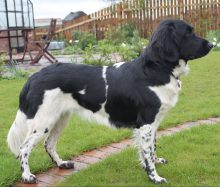Stabyhoun
Lifestyle Needs
 The Stabyhoun is a rare breed in the UK and fairly rare in its country of origin, Holland. The breed is not recognised by the UK Kennel Club. It has a retrieving/pointing background but is equally suitable as a family pet or companion dog. The Stabyhoun is said to be calm, patient and reliable, easy to please and generally good with children. It’s average height is 19-21 inches and weighs 15 – 20 kg. His coat requires little grooming and is reputed to be ‘self cleaning’, for drying quickly and for not having a typical ‘doggy smell.’ He will need at least one hour’s exercise every day, including free running. Ideally she should have challenges such as agility to exercise her mind. A house with a garden and access to the open countryside would also be required.
The Stabyhoun is a rare breed in the UK and fairly rare in its country of origin, Holland. The breed is not recognised by the UK Kennel Club. It has a retrieving/pointing background but is equally suitable as a family pet or companion dog. The Stabyhoun is said to be calm, patient and reliable, easy to please and generally good with children. It’s average height is 19-21 inches and weighs 15 – 20 kg. His coat requires little grooming and is reputed to be ‘self cleaning’, for drying quickly and for not having a typical ‘doggy smell.’ He will need at least one hour’s exercise every day, including free running. Ideally she should have challenges such as agility to exercise her mind. A house with a garden and access to the open countryside would also be required.
Genetic Diversity
(Known as Coefficient of Inbreeding: 'COI'. It should be as low as possible.)
Because of the low numbers in this breed, the Dutch Stabyhoun Association approves all matings worldwide to avoid high coefficients of inbreeding and to make use of all available genetic material within the breed.
See 'A Beginners Guide to COI'
Gene Pool Size
(Known as Effective Population Size: 'EPS')
TBC
EPS is a measure of how many individuals are contributing genetically to a breed population. It is a measure of the size of the gene pool in a breed. Lower than 100 is considered critical by conservationists and below 50 brings a breed close to extinction. For more information see the Kennel Club article.
Health and Welfare Problems due to Conformation
(Body shape and physical characteristics)
None known
BVA/KC Health Schemes: www.bva.co.uk/chs
- Hip Dysplasia (should be lower than 18)
- Elbow Dysplasia: score should be as low as possible ideally 0:0
- Eye Disease
Estimated Breeding Values (EBVs) : No EBVs are currently available for this breed
www.thekennelclub.org.uk/about-ebvs
DNA Tests Available
DogWellNet and IPFD Harmonisation of Genetic Testing for Dogs (HGTD)
www.dogwellnet.com/breeds
- von Willebrand’s disease (type 1 vWD)
- Cerebral Dysfunction
Availability of a DNA test does not mean that it is always necessary or even desirable for breeders to use this test.
Other Breed-Specific Health Screening Schemes
Contact the UK Stabyhoun Association for additional information:
www.stabyhounuk.com
Ask the breeder to show you the certificates for the above tests/screening for both parents. If any of the above tests have not been considered necessary by the breeder (and there may be good reasons), ask her to explain why.
Other Diseases Reported
(For which there are currently no genetic or screening tests for sire or dam)
- Epilepsy
- Patent ductus arteriosus (PDA)
Ask the breeder about the medical history of the parents, grandparents and great grandparents. Consider carefully whether to purchase a puppy if some of these or other diseases are in the family line.
Ask about the breeder’s policy in cases of serious genetic diseases occurring to your puppy in later life. Good breeders will request to be informed of such events in order to improve future breeding decisions.
You are strongly advised to buy from a breeder who uses (or is prepared to use) the AWF Puppy Contract and Puppy Information Pack (PIP): www.puppycontract.org.uk
The breeder should also be familiar with the CFSG/DBRG Code of Practice for Dog Breeding
Or the Kennel Club’s Assured Breeders Scheme Standard and Guidance:
Standard PDF | Guidance PDF